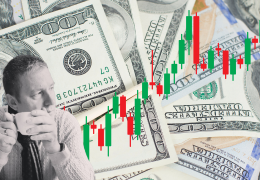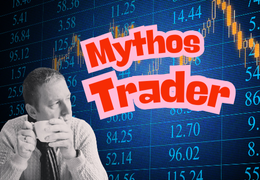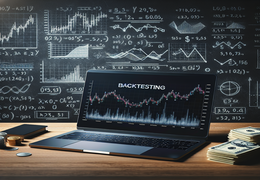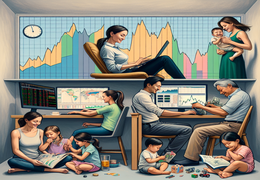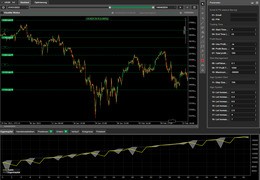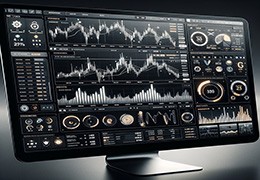Between reality and illusion If you want to know what trading really means—beyond luxury cars, piles of cash, and...
Trading ist wie Autofahren lernen: Eine bildliche Anleitung
Trading is like learning to drive a car: A visual guide
Introduction
Trading and driving may seem to have little in common at first glance, but a closer look reveals astonishing parallels. Both require patience, practice and an understanding of basic rules. In this article, I, Lech, a trader and mentor with over 30 years of experience, would like to show you how learning to trade is similar to the process of driving a car.
Chapter 1: The first enthusiasm
Young people are often fascinated by driving. They see their parents or older siblings behind the wheel and dream of taking control themselves. As a passenger, they gain their first impressions: how to use the indicator, press the clutch or react to traffic signs. Video games or driving simulators allow them to take their first steps in a safe environment—similar to trading on a demo account, where no real money is at stake. They may even be allowed to drive themselves in an empty parking lot, under adult supervision. These experiences increase their enthusiasm and desire to finally be able to drive themselves.
It's the same with trading. You hear stories of successful traders, maybe see someone in your family or circle of friends who is involved in stocks. The financial markets seem exciting and full of opportunities. First contact often comes through stock market games or demo accounts, where you can test how investments develop without risk. Sometimes you try to invest small amounts in the hope of quick profits—similar to a teenager who thinks he can master the streets after a few rounds on the simulator. This initial enthusiasm is important, but it should be complemented by solid learning and practice in order to be successful in the long term.
Chapter 2: Understanding the theory
Before you can actually get behind the wheel of a car, it is essential to learn the traffic rules. You go to driving school, study traffic signs, learn about right-of-way rules and understand the meaning of traffic lights. Without this theoretical knowledge, driving would be dangerous and irresponsible. It is the same with trading: before you invest real money, you have to understand the basics of the market. You learn about different financial instruments, market mechanisms and trading strategies.
An example from driving school is understanding the meaning of speed limits. These are there to ensure the safety of all road users. In trading, this corresponds to risk management, where you determine how much capital you want to risk per trade. Another example is learning about right-of-way rules to avoid accidents. In trading, you need to know the market rules and times in order to trade effectively.
In addition, a student driver learns how to react to unforeseen situations, such as sudden obstacles. In trading, you also have to be prepared for market volatility and know how to react in turbulent times. Another example is understanding vehicle technology—how to use the gearshift, clutch and brake correctly. In trading, this corresponds to dealing with the trading platform and the various order types.
Finally, knowledge of first aid measures is part of driving school training. You have to know how to react in an emergency. In trading, this means having strategies in place in case of losses and knowing when to exit the market. Overall, the theoretical training lays the foundation for safe and successful trading, both in driving and in trading.
Chapter 3: Practical exercises with instructions
After the theoretical foundations have been laid, the learner driver begins practical driving lessons under the supervision of an experienced driving instructor. At the beginning, many things feel strange: the correct clutch, starting on a hill or estimating distances. The driving instructor is always sitting next to you, giving advice and intervening if necessary to avoid dangerous situations. This supervised learning allows the student to make mistakes and learn from them without risking serious consequences.
In trading, this process corresponds to the phase in which you make your first real trades under the guidance of a mentor. You put the theoretical knowledge you have acquired into practice and learn how to use trading platforms effectively. The mentor observes the decisions, gives feedback and helps to refine strategies.
An example from driving school is practicing parking. At first, it seems complicated to maneuver the vehicle precisely between two cars. But with the instructor's guidance and repeated practice, it becomes routine. In trading, this could be the equivalent of learning the right timing when entering and exiting trades.
Another example is driving in different traffic situations—in the city, on country roads or motorways. Each environment presents its own challenges, and the driving instructor helps you to master them safely. In trading, you also learn to act in different market conditions—be it in volatile phases, during sideways movements or during trending markets.
The student driver also learns how to react to unforeseen events, such as suddenly appearing obstacles or changes in the weather. The driving instructor provides strategies to safely handle such situations. In trading, you also have to be prepared for unexpected market changes and know how to adjust your portfolio accordingly.
Another important area of practice is navigating complex intersections and roundabouts. Here, anticipatory driving and understanding the right-of-way rules are crucial. In trading, this corresponds to managing several positions at the same time and paying attention to various market indicators.
Finally, the driving instructor boosts the student's confidence by giving positive feedback and highlighting successes. In trading, emotional support from a mentor is equally important to boost self-confidence and avoid emotional decisions.
Chapter 4: Passing the exam
Once the learner driver has gained sufficient practical experience, the decisive driving test is about to take place. This moment is often associated with nervousness and excitement, because the driver has to apply what he has learned under the supervision of an examiner. The test not only tests technical skills such as starting on a hill or parking, but also the understanding and application of traffic rules in real traffic. Passing the test confirms that you are ready to take part in road traffic independently and responsibly.
In trading, this step corresponds to the transition from accompanied trading under the guidance of a mentor to independent trading. After intensive preparation and practice, it is time to make your own decisions and implement them without direct support. An example of this is creating your own trading plan based on individual strategies and risk management principles. Like the student driver who plans his route and obeys traffic rules, the trader must conduct his market analysis and make trading decisions.
Another analogy is overcoming test anxiety. While the learner driver may be nervous and under pressure, he still needs to keep a clear head. In trading, the fear of loss or the excitement of potential gains can lead to emotional decisions. This shows how important it is to overcome psychological barriers and act with discipline.
The driving test also includes reacting to unexpected situations, such as suddenly appearing obstacles or unpredictable behavior of other road users. In trading, you also have to be prepared for unpredictable market movements and be able to react flexibly. For example, surprising news can influence the market and the trader must quickly decide whether to hold, sell or buy his position.
Another aspect is compliance with rules under observation. During the test, close attention is paid to whether the learner driver follows the traffic rules. In trading, this corresponds to compliance with trading regulations and ethical standards. Violations can have serious consequences, both legal and financial.
Finally, passing the driving test symbolizes the beginning of a new phase in life full of opportunities and responsibilities. You get your license and can now drive independently, whether to work, travel or discover new places. In trading, acting independently means that you are now able to pursue your own financial goals, whether by building a portfolio, specializing in certain markets or developing advanced trading strategies.
However, passing this trading "test" is not the end of the learning process. Like a new driver who continues to gain experience and improve his skills, the trader should always be willing to learn and adapt to changing market conditions. Continuous education and self-reflection are key components of long-term success.
Chapter 5: Independent driving and independent action
After passing the test, the young driver begins his journey into the world of independent driving. Without the driving instructor at his side, he is now solely responsible for every decision behind the wheel. This new chapter is exciting but also challenging. You gain experience, develop a feel for the vehicle and learn to react to different traffic situations. Likewise, the trader begins to trade independently after the training phase. Here are detailed comparisons and examples that shed light on this phase:
- Broadening your experience: A new driver will gain confidence over time by experiencing different routes and conditions—city traffic, country roads, highways. Likewise, a trader will broaden his knowledge by trying out different markets and financial instruments, from stocks to forex to derivatives.
- Adaptation to changing conditions: Weather conditions such as rain, snow or fog affect driving behavior. A responsible driver adjusts speed and driving style accordingly. In trading, you have to react to market changes—be it due to economic news, political events or global crises—and adapt your strategies.
- Developing routines: Over time, a driver establishes routines, such as checking mirrors regularly or using the turn signal early. These habits increase safety. A trader also develops routines, such as daily market analysis, setting stop-loss limits or keeping a trading diary for self-reflection.
- Independent problem solving: Breakdowns or technical problems can occur. An experienced driver knows how to change a tire or refill fluids. In trading, you will encounter technical challenges such as system failures or software problems. A competent trader knows alternatives and solutions to continue trading.
- Responsibility and ethics: When driving, you are responsible not only for yourself, but also for other road users. Consideration and compliance with the rules are essential. Ethical behavior is also important in trading. Insider trading or market manipulation are not only illegal, they also undermine trust in the markets.
- Emotional control: In traffic, stressful situations such as traffic jams or aggressive drivers can cause emotions to run high. A prudent driver stays calm and makes rational decisions. In trading, losses or volatile markets can trigger emotions such as fear or greed. Successful traders learn to control these emotions and not act impulsively.
- Long-term planning: A driver plans long trips carefully, takes breaks into account and chooses the optimal route. A trader plans his financial goals, develops long-term strategies and diversifies his portfolio to minimize risks and maximize opportunities.
- Safety awareness: Wearing seat belts, keeping your distance and obeying speed limits are measures for your own safety and that of others. In trading, you protect your capital through risk management, setting stop-loss orders and only investing money that you are willing to risk.
- Use technological tools: Modern cars offer assistance systems such as cruise control or lane departure warning. A driver uses these technologies to make driving more pleasant and safer. Traders use technical analysis tools, algorithms or automated trading systems to trade more efficiently and make better decisions.
- Network and community: Many drivers join clubs or communities to exchange experiences and learn from each other. In trading, exchanging ideas with other traders in forums, seminars or network meetings is valuable in order to share knowledge and develop further.
Driving and trading independently is a phase of growth and self-development. It's about taking responsibility, gaining experience and learning continuously. Just like driving a car, you become more confident and competent in trading with each passing day. You recognize patterns, develop intuition and are able to react better and better to different situations. The key to success lies in the combination of theoretical knowledge, practical experience and the willingness to constantly develop.
Chapter 6: Dealing with setbacks
After some time on the road or in the financial markets, every driver and trader will sooner or later face setbacks. Accidents, breakdowns or bad decisions are part of the learning process. What is important is how you deal with these challenges and what lessons you learn from them. Here are detailed comparisons and examples that shed light on how to deal with setbacks in driving and trading:
- Accept small accidents and losses: A minor rear-end collision or a scratch on your car can happen to anyone. It's annoying, but you usually learn from it, for example to keep more distance or park more carefully. In trading, small losses correspond to these accidents. Perhaps you closed a trade too late or misjudged a market development. These losses should be seen as a lesson from which you can gain valuable knowledge.
- Analysis of the cause of the error: After an accident, people often check what went wrong. Was it inattentiveness, excessive speed or a misjudgement of the situation? In trading, error analysis is just as important. You should regularly review your trades to identify patterns that lead to losses. This can help avoid future errors and optimize your trading strategy.
- Dealing with setbacks emotionally: An accident can be emotionally stressful, and some people develop fears or insecurities when driving. Similarly, a large loss in trading can lead to self-doubt or fear of further investments. It is important to recognize and manage these emotions. In traffic, one could regain confidence by taking additional driving lessons or talking to experienced drivers. In trading, it helps to practice emotional discipline and, if necessary, talk about the experience with a mentor or coach.
- Rebuilding after major setbacks: More serious accidents can result in the car being totaled. This requires not only financial resources for a new vehicle, but also time to rebuild confidence. In trading, a large loss can significantly reduce or even wipe out your trading account. In such cases, it is crucial to take a step back, assess the overall situation and develop a plan to start again. This could mean practicing again with a demo account or fundamentally revising your trading strategy.
- Take preventive measures: After an accident, many drivers are motivated to improve their driving skills and take preventive measures. This can include taking part in driver safety training or installing assistance systems. In trading, you should also take preventive steps to minimize future losses. This includes setting stop-loss orders, diversifying your portfolio or adhering more strictly to risk management rules.
- Acceptance of the unpredictable: Some events are beyond our control, such as sudden changes in the weather or the misbehavior of other road users. A responsible driver accepts these risks while remaining alert. In trading, there are also unpredictable market movements triggered by global events or news. A good trader recognizes that he cannot control everything and adapts his strategy accordingly.
- Insurance and protection: In road traffic, good insurance protects against the financial consequences of an accident. Similarly, in trading, you can protect yourself against losses by using hedging strategies or the use of options. These measures cannot completely eliminate the risk, but they do offer a certain level of security.
- Learn from the experiences of others: You often hear about the experiences of other drivers, whether through conversations or media reports. These stories can offer warnings or valuable lessons. In trading, talking to other traders, reading books or studying case studies is a great way to learn from the mistakes and successes of others.
- Develop patience and persistence: Setbacks can be frustrating, but they are also an opportunity to practice patience and persistence. A driver who gets back in the car after an accident shows resilience. A trader who continues to learn and adjust his strategy despite losses shows perseverance. These qualities are essential for long-term success both on the road and in the markets.
- Celebrate successes after setbacks: After overcoming a setback, it is important to recognize and celebrate the progress you have made. Regaining confidence in driving after an accident is a big step. In trading, you should recognize small successes, such as a series of successful trades after a losing streak. These positive experiences build self-confidence and motivate you for the future.
Dealing with setbacks is an integral part of the learning process in both driving and trading. It's not about avoiding mistakes entirely—that's impossible. Rather, it's about learning from those experiences, continually improving, and remaining resilient. By seeing setbacks as learning opportunities and taking proactive action, you lay the foundation for long-term success and personal growth. On the road and in the financial markets, the journey is the destination, and every step, whether forward or backward, contributes to the bigger picture.
Chapter 7: Continuous training
The learning process does not end with obtaining a driver's license or making your first successful trade. In both driving and trading, continuous education is key to refining skills, staying up to date and adapting to changing conditions. In this chapter, we will explore the importance of continuous development and draw parallels between special driving training and continuous learning in trading.
- Special training for special situations: Experienced drivers often take part in driver safety training to improve their skills. For example, they learn how to keep the vehicle under control in aquaplaning situations or practice driving on icy roads. In trading, this corresponds to learning new trading strategies or dealing with special market situations such as high volatility. For example, a trader could familiarize themselves with options trading, algorithmic trading or risk management strategies.
- Adapting to technological developments: Automotive technology is constantly evolving—from driver assistance systems to electric vehicles to autonomous driving features. A responsible driver stays informed and adapts to take advantage of new technologies and stay safe. In trading, this means getting to grips with new trading platforms, analysis tools or market instruments. For example, artificial intelligence and machine learning could be used to analyze market trends.
- Regularly refresh your knowledge: Traffic rules can change, new laws come into force and road traffic regulations are updated. Drivers should therefore regularly refresh their knowledge. In trading, it is similarly important to keep up to date with regulatory changes, tax aspects or new market regulations. This ensures that you always act compliantly and avoid unpleasant surprises.
- Feedback and coaching: Even experienced drivers can benefit from feedback, whether from fellow passengers, driving instructors or by studying their own journeys using dashcams. This feedback helps to identify blind spots and improve driving habits. In trading, keeping a trading diary is a tried and tested method for reflecting on your own decisions. In addition, exchanging ideas with other traders or engaging a coach can help to analyze and improve your own performance.
- Networking and exchanging experiences: Car clubs or carpools offer platforms to exchange ideas with like-minded people, share experiences and learn from each other. Networks, seminars and workshops are valuable resources in trading. By exchanging ideas with other traders, you can gain new perspectives, share market information and discuss common strategies.
- Adaptation to global changes: Environmental awareness and sustainability have a strong influence on the automotive industry. Electric cars and alternative drive technologies are becoming more important. Drivers must adapt to these changes. In trading, global events such as economic crises, political changes or technological innovations affect the markets. A trader must follow these developments and adapt his strategies accordingly.
- Psychological development: Safe driving requires not only technical skills but also mental strength—patience, concentration and stress management. Drivers can learn techniques to improve their mental fitness. In trading, psychology is a critical factor for success. Emotional discipline, the ability to accept losses and avoiding overtrading are areas where ongoing education and self-reflection are important.
- Specialization and diversification: Some drivers decide to acquire additional driving license classes, such as for motorcycles, trucks or buses. This expands their options and skills. In trading, you can also specialize, for example in certain markets such as forex, commodities or cryptocurrencies, or learn different trading styles such as day trading, swing trading or long-term investing. At the same time, portfolio diversification is a strategy to minimize risks and maximize opportunities.
- Participating in competitions and challenges: Motorsport events or driving competitions offer drivers the opportunity to test their skills and compete against others. Trading also has competitions and challenges where traders can put their strategies to the test. Such events encourage learning, ambition and often offer new insights through observing the competition.
- Lifelong learning as an attitude: Ultimately, the willingness to learn throughout your life is an attitude that characterizes both good drivers and successful traders. The world is constantly changing, and those who stand still risk falling behind. By remaining open to new things, regularly taking advantage of training opportunities and proactively developing yourself, you lay the foundation for lasting success and personal satisfaction.
Summary
Continuing education is not a luxury, but a necessity—on the road as well as in the financial markets. The ability to adapt, learn new things and continually improve is what separates the average driver from the excellent and the occasional trader from the successful. It's about enjoying the journey, staying curious and seeing every day as an opportunity to get better.
Final thoughts
As with driving a car, the journey is the destination in trading. With commitment, a willingness to learn and the right support, you can continually develop your skills. You are in good hands with me. With over 30 years of experience, I will be your mentor and accompany you on your personal trading journey. Together we can achieve your goals and master the challenges of the financial markets.
Closing words
Trading is like learning to drive a car—a journey full of challenges, growth, and continuous learning. Both paths begin with initial enthusiasm, followed by the acquisition of theoretical knowledge and practical experience under the guidance of a mentor or teacher. Setbacks are inevitable, but they offer valuable lessons and promote personal development. Constant training and adaptation to new conditions are crucial to long-term success and safety.
As with driving a car, patience, practice and following the rules will lead you to your goal. It's not just about reaching your goal, but also about planning your journey there consciously and responsibly. With the right support and attitude, you can overcome the challenges and constantly improve your skills.
You are in good hands with me. With over 30 years of experience in trading, I am at your side as a mentor. Together we can design your personal trading path, overcome obstacles and discover the fascinating opportunities of the financial markets. Let's turn the key to success together and start the journey.
Lech

